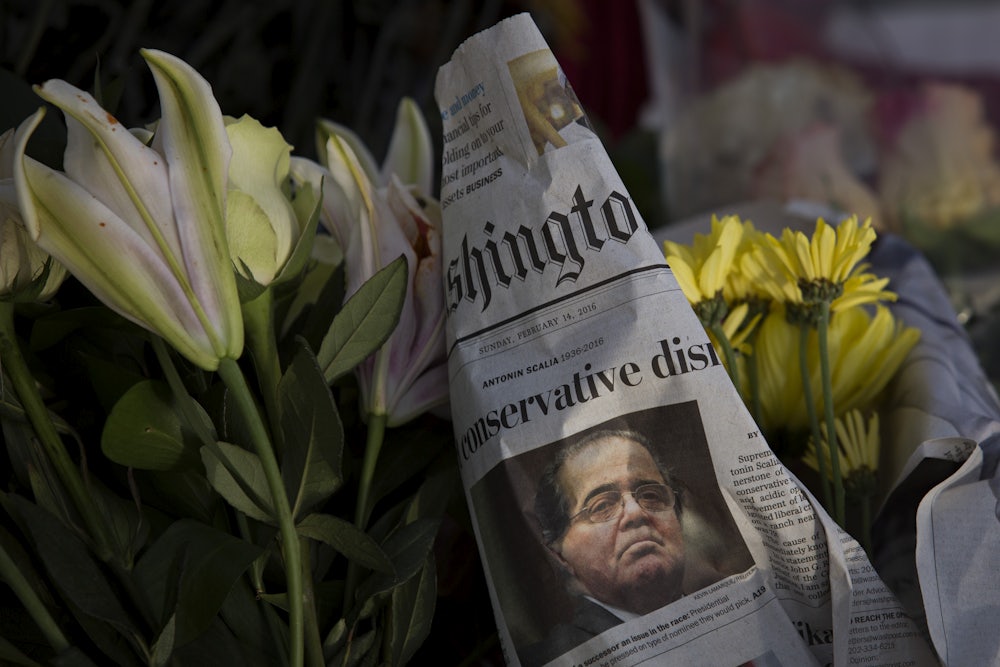Sri Srinivasan is one of the names being floated to fill the Supreme Court seat vacated by the death of Antonin Scalia. But the aspects of Srinivasan’s record that make him a favorite to eke out an improbable confirmation from the GOP-controlled Senate are precisely those that are considered flaws by progressives.
Before his appointment to the U.S. Court of Appeals for the District of Columbia Circuit in 2013—confirmed 97-0 by the Senate—Srinivasan built a career at a firm that defended ExxonMobil and the mining company Rio Tinto from allegations of human rights abuses in Indonesia and Papua New Guinea. This is why Jamie Henn, co-founder of the climate group 350.org, is already describing Srinivasan’s record as “mixed” and referring to the defense of ExxonMobil as “deeply disturbing,” according to Politico.
It may seem like an academic exercise to preemptively criticize Srinivasan, since the chances of him being confirmed, at this point, appear close to zero. But Obama’s short list deserves scrutiny, since one person on that list may eventually be confirmed, if not under Obama, then under a Democratic successor. Climate activists, in particular, will be watching closely. For better or worse, the next Supreme Court has the power to alter the fate of the world.
As long as Congress remains divided, it will be the Supreme Court that defines the limits of what the Environmental Protection Agency can do to combat climate change for years to come. To understand how important the Supreme Court is to shaping the U.S.’s climate change policy, it helps to look back. The EPA’s powers to fight climate change have been mostly defined, even bolstered, by a number of key cases.
The Clean Air Act, passed by Congress in 1970 and strengthened in 1990 when the climate denial movement was nascent, forms the basis of President Barack Obama’s response to climate change. But the act did not include greenhouse gases on the list of pollutants the EPA was compelled to regulate. Over the years, the court has empowered the agency to regulate such pollutants, through the way it has interpreted the Clean Air Act and the EPA’s authorities (Scalia, it’s worth noting, was often antagonistic toward the EPA).
The landmark 1984 case Chevron v. Natural Resources Defense Council gave federal agencies a wide latitude to reasonably interpret statutes that were left vague by Congress. That precedent has long worked in the EPA’s favor—and its track record of winning a majority of court challenges since 2010 proves it. When President George W. Bush was still in office, the court decided for the first time in Massachusetts v. EPA that greenhouse gases qualify as an “air pollutant” under the act, if the EPA found it was a danger to public health. That decision was reinforced in 2011, when the court in American Electric Power v. Connecticut upheld a similar power for the EPA to regulate carbon pollution from new power plants. Obama would not have had the legal power to issue sweeping carbon pollution regulations for cars and power plants if the Supreme Court had decided differently.
The Court’s steps in the next few years could arguably be even more critical, and we got a frightening reminder last week, just days before Scalia’s death, that decisions could also swing the other way. The Court on a 5-4 vote issued an order last Tuesday to halt the EPA’s plan to curb carbon pollution from power plants, in what was the earliest stay of a federal regulation in the history of the Court. It was a worrying sign that a majority of the Court was preparing to eventually strike it down. If the EPA’s plan is thrown out, then a hard-won international climate change agreement reached in Paris last December could quickly go with it. After all, if the Supreme Court undercuts the centerpiece of the U.S.’s promise to tackle climate change, then U.S. allies have little incentive to follow through with their own pledges.
Scalia’s death, of course, robs the current Court of a conservative vote, which gives the EPA the advantage in this particular dispute. But that also means his replacement could be the deciding vote to protect the limited federal progress we’ve seen on climate change.
The next justice will be
critical in determining the fate of Obama’s climate plan. Beyond that, the next justice will help the Court decide how far the next president can go it alone on climate change.
Experts think the Clean Air Act has more room in it to tackle pollution beyond power plants, indeed across the entire economy, but whether the Supreme Court will agree is another question. According to a report by legal experts at Columbia, New York University, and University of California, Los Angeles, there is an unused “International Air Pollution” provision in Section 115 of the Clean Air Act. This could mean a revolutionary approach to regulating pollution:
The language of Section 115 does not limit the agency to regulating a particular source-type, or a given industrial or economic sector. Rather, it grants EPA and the states broad latitude to address international air pollution comprehensively through the Clean Air Act’s State Implementation Plan process, increasing administrative efficiency and reducing burdens on regulated companies. EPA and the states could use the provision to establish an economy-wide, market-based approach for reducing [greenhouse gas] emissions.
The Paris deal may have opened the door to this interpretation, these experts argue, because Section 115 states the EPA or the secretary of state can act on air pollution that “may reasonably be anticipated to endanger public health or welfare in a foreign country.”
While the occupant of the Oval Office is of immense importance to climate change, the effectiveness of the president partly resides in the person he or she will appoint to the Supreme Court. Scalia’s replacement will help determine the Clean Power Plan’s legacy, and could dramatically redefine how the U.S. responds to climate change. A little extra scrutiny of Obama’s favored candidates wouldn’t hurt.
